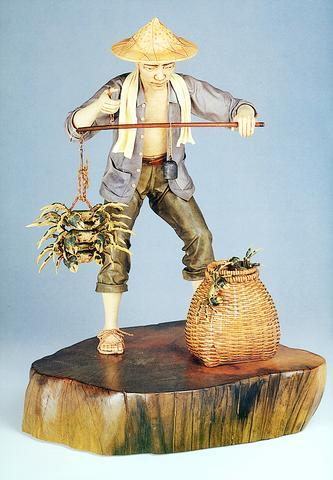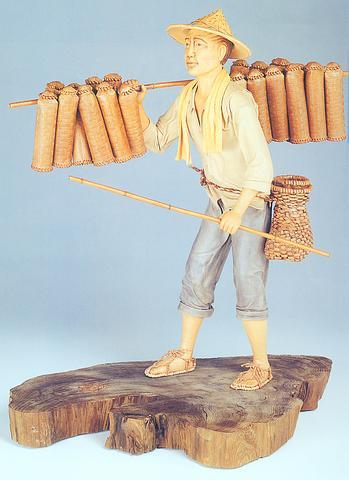A winner of the Ethnic Crafts Award, the country's highest honor in crafts, Yeh fa-yuan (
Titled "Harvest Series," the 30 works form a picture of 1960s rural Taiwanese villages. Farmers are depicted carrying pumpkins with strained, yet contented expressions. Others work at the rice grinder, or weigh the corn. All have crow's feet and weathered lips on their heavily tanned faces. Through subtle expressions, their faces show a serenity of diligent farmers and idyllic agricultural life.

PHOTO COURTESY OF TAIWAN CRAFT DESIGN CENTER
These are figures from Yeh's childhood memories in Taoyuan County. "Agriculture used to be an important part in Taiwanese people's lives, but agriculture has declined now. I hope that through these sculptures, I can express the joy of harvest in rural families so that young people will appreciate the happiness of old-time farmers," Yeh said.

PHOTO COURTESY OF TAIWAN CRAFT DESIGN CENTER
To present the rural life as realistically as possible, Yeh gathered many books, documents and photo albums of 1960s Taiwan and paid meticulous attention to farming tools. When he completed a work, he had his 83-year-old mother examine it to make sure that every detail of the scene is historically correct. He even took photos of farmers to study the wrinkles on their faces and carve the holes of fishing nets one by one to create vivid images.
In his previous series of crabs and ants, Yeh also tried to make extremely realistic works by raising crabs and ants in his house to study their anatomy closely. Yeh studies human anatomy by having his wife take hundreds of photos of him acting out the scenes he was going to sculpt.
It's also surprising that aside from the few machine parts of the farming tools, which are made of metal, these sculptures are made entirely of bull leather, including tasseled straw shawls and corn ears. "The most difficult part of leather sculpting is knowing the characteristics of leather, once you choose the right kind of leather, you can have it form the right structures at your will," Yeh said, adding that he insisted on working with such a challenging and costly material because of its unique warm colors that seem to exude a life of their own.
Yeh started creating leather sculptures in the 1980s, when leather works in Taiwan were mostly two-dimensional pieces to hang on the wall. He found that leather, highly malleable and easy to dye, was actually an ideal material for realistic sculpture.
To make the leather even more lifelike and durable, he spent more than one month on each piece processing the leather to be water-proof and mildew-proof.

In the March 9 edition of the Taipei Times a piece by Ninon Godefroy ran with the headine “The quiet, gentle rhythm of Taiwan.” It started with the line “Taiwan is a small, humble place. There is no Eiffel Tower, no pyramids — no singular attraction that draws the world’s attention.” I laughed out loud at that. This was out of no disrespect for the author or the piece, which made some interesting analogies and good points about how both Din Tai Fung’s and Taiwan Semiconductor Manufacturing Co’s (TSMC, 台積電) meticulous attention to detail and quality are not quite up to

April 21 to April 27 Hsieh Er’s (謝娥) political fortunes were rising fast after she got out of jail and joined the Chinese Nationalist Party (KMT) in December 1945. Not only did she hold key positions in various committees, she was elected the only woman on the Taipei City Council and headed to Nanjing in 1946 as the sole Taiwanese female representative to the National Constituent Assembly. With the support of first lady Soong May-ling (宋美齡), she started the Taipei Women’s Association and Taiwan Provincial Women’s Association, where she

Chinese Nationalist Party (KMT) Chairman Eric Chu (朱立倫) hatched a bold plan to charge forward and seize the initiative when he held a protest in front of the Taipei City Prosecutors’ Office. Though risky, because illegal, its success would help tackle at least six problems facing both himself and the KMT. What he did not see coming was Taipei Mayor Chiang Wan-an (將萬安) tripping him up out of the gate. In spite of Chu being the most consequential and successful KMT chairman since the early 2010s — arguably saving the party from financial ruin and restoring its electoral viability —

It is one of the more remarkable facts of Taiwan history that it was never occupied or claimed by any of the numerous kingdoms of southern China — Han or otherwise — that lay just across the water from it. None of their brilliant ministers ever discovered that Taiwan was a “core interest” of the state whose annexation was “inevitable.” As Paul Kua notes in an excellent monograph laying out how the Portuguese gave Taiwan the name “Formosa,” the first Europeans to express an interest in occupying Taiwan were the Spanish. Tonio Andrade in his seminal work, How Taiwan Became Chinese,